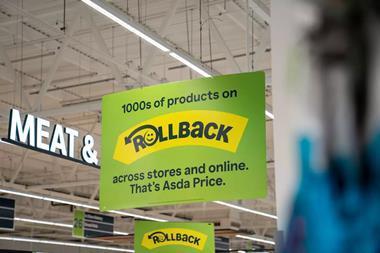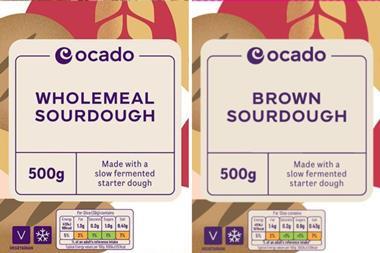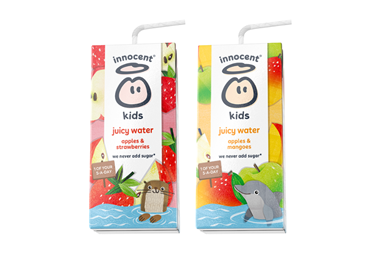Round pound deals seem to be everywhere these days. Peter Cripps asks why they have suddenly become so ubiquitous and just what is their appeal
Shoppers may be watching every penny at the moment, but it is the pound that is becoming the battleground as far as the supermarkets are concerned.
The round pound has become the latest weapon in the price war. “Britain’s biggest discounter”, Tesco, is now creating “Pound Shop” zones in stores - aisles on which everything is priced at round pound prices, while Asda has gone one step further and, cheekily echoing its rival’s claim, declared itself to be “Britain’s biggest pound operator” with 7,000 products on sale for £1.
“Pound deals are very successful as footfall drivers and consumers are really buying into them,” says Maria Manly, Birds Eye’s insight director. “The pound deal is the new bogof - retailers are demanding pound deals all the time now.”
But why the round pound’s sudden popularity? Will it last? Or will consumers get fractious about the shrinking number of fractional prices?
The discount message evolves
The grocery landscape has traditionally been dominated by 99p and other fractional price points, the theory being that consumers psychologically view the 1p difference to be more significant than it actually is and therefore regard a £1.99 ready meal, for instance, as offering greater value for money than a £2 one. Some retailers argue that it also deters staff theft as cashiers are more likely to have to open the till to give shoppers change - and less likely to bypass it and pocket the money.
Over the past few years, however, there has been a subtle change in attitude, says Dr David Lewis, director of research at Mindlab International at the University of Sussex and author of The Soul of the New Consumer. The penny has become the new pound, he suggests. “The pound is the equivalent of the penny bazaar in Woolworths,” he says. “If it’s not good value, who cares, it’s only a pound. On the other hand, as shoppers have become more sophisticated they have seen through 99p deals. They round it up in their heads anyway and are not interested in getting a penny change.”
They are interested, however, in the round pound - thanks in no small part to the foundations laid by Iceland founder Malcolm Walker eight years ago. When he was ousted from Iceland in 2001 he set up the Cooltrader chain of frozen stores where he trialled round pounds. Consumers took to them, so he introduced them to Iceland stores when he was reinstated in 2005. “We decided the pound was honest and more simple,” he says. “It helps people keep track of what they are spending.”
Thanks to the success of Iceland and fixed price retailers such as Poundland, consumers soon started to associate round pound price points with value for money.
It didn’t take the big four long to latch on, but significantly, they focused their initial efforts on the promotional end of the spectrum, opting for bargain buckets and gondola end deals rather than permanent lines. Only recently have they started to make round pound deals a core part of their offer by introducing more permanent lines alongside the existing promotional lines, merchandising them in dedicated areas and overtly marketing themselves as pound operators.
The recession has clearly been a catalyst. Retailers have been falling over themselves to convey the message that they offer value in as many ways as they can. First they took on the hard discounters and now, it seems, they’ve got the round pound retailers in their sights. Fixed price retailers are enjoying strong sales growth - Iceland’s sales rose 16% to £2.1bn in the year to March, with pre-tax profits up 84% to £114m, while Poundland’s sales rocketed 20% to £396m. Conversely, the hard discounters are seeing growth tail off.
How retailers weigh up pound-for-pound
Asda: the “biggest pound operator” with 7,000 lines for a quid (including permanent lines). More than a quarter (27%) of its total featured promotions are now accounted for by £1 deals.
Tesco: has more than quadrupled the number of £1 promotions in the past year from 382 to 1,622 to account for 12% of promotions. It recently started putting Pound Shops into larger stores.
Morrisons: with 1,395 lines on promotion at £1 in the year to date, it has almost as many £1 deals as Tesco and they accounted for 10% of its promotions over the past year.
Sainsbury’s: has more than trebled lines on promotion at £1 to 892 in the past year to account for 6% of promotions.Iceland: claims 30% of its 2,500 lines are priced at £1, and 70% of these have been for more than six months.
Source: Assosia/retailers
The big four are reluctant to divulge the percentage of promotional to permanent round pound lines - or whether they see them as a core part of their offer in the long term. With the number of promotions on the rise generally, it is no surprise round pound deals are becoming an increasingly important part of the mix. The number of £1 promotions in the big four has shot up from 2,851 in the year ending June 2008 to 7,382 in the past year - more than 150% - while the number of promotions in general has risen just 6% [Assosia]. Offers at £1 now account for 13% of all featured promotional space compared with 5% a year ago.
Their growing importance is backed up by the latest sales figures: permanent and promotional £1 lines accounted for 7.4% of total grocery sales in June, compared with 4.5% last June - or £511m versus £295m [TNS]. It’s a similar story for £2 and £3 lines, which accounted for 3.1% and 1.3% of sales respectively.
Asda has had the most featured pound promotions over the past year - nearly 3,000, almost double the number of the previous year [Assosia]. It now boasts 7,000 £1 lines including permanent lines, says Asda’s chief merchandising officer,
Darren Blackhurst, who agrees that round pounds make shopping simpler.
“If you watch customers, they count the cost as they go,” he says. “Whole pounds make this easier. If customers see something that used to trade at £1.70 reduced to £1, they know what they’re saving.”
At a time when cynicism towards politicians and corporations is growing, it is important for retailers to give consumers a message that they can trust, adds Lewis. “A £1 price point has a what-you-see-is-what-you-get honesty to it,” he says.
This sense of trust is borne out by the data. Consumer research agency Him! says 53% of shoppers polled this year liked pound deals and only 11% disliked them.
But the key point is that consumers associate £1 lines with great deals - and though prices can obviously be rounded up as well as down, the emphasis of the retailers’ marketing strategies is very much on the latter. Indeed, the secret to making round pound price points work is demonstrating prices have been rounded down, says Blackhurst, adding that the round pound promotions will be restricted largely to staples because of the investment required.
Look at any of the big four’s recent advertising campaigns and you’re likely to see round pounds feature prominently. That’s because they present a fantastic merchandising and marketing opportunity - and really get the value message across to consumers, says a Tesco spokesman.
“We’re a pretty progressive retailer and like to do different things to attract different customers,” he says. “Our Pound Shops are proving very popular in larger stores. All we have done is put items that cost £1 together. It’s about how we talk to consumers. They’re things we’ve collected from around the store. It’s just another way of engaging with the customer.”
Price-war weapon
It is not just the mults that have woken up to the virtues of the round pound. Ged Carter, marketing director of Spar wholesaler AF Blakemore & Son, launched a Pounds Down campaign at the beginning of the year.
Manufacturers are adjusting their own pricing and NPD strategies accordingly, altering pack sizes and creating multibuy deals to provide their retail customers with bespoke round pound products. Whitworths created a special 1.5kg bag of sugar specially for Poundland, for instance. Sugar, which normally comes in 1kg bags, typically costs 93p in the mults whereas Poundland can offer consumers an extra 500g for only 7p, says Poundland chief executive Jim McCarthy.
Frozen manufacturer Birds Eye, meanwhile, embraced the pound price point earlier this year with its Make Your Pound Go Further campaign. Many of its products, including its relaunched Arctic Roll, were marketed at a pound and it invested more than £1m in a TV ad campaign that featured a pound coin rolling past its products.
Manly nevertheless expresses concern about the number of £1 lines on offer and their impact on manufacturers. “There are not many of our products we can put permanently at a pound,” she says. “Consumers really just want value. They are buying things at a pound because that’s what they are being offered.”
It’s unlikely the big four will adopt Iceland’s strategy and give all their products round price points, says Chris Outram, partner of strategy consultancy OC&C. They simply have too many SKUs to abandon fractional pricing and will also be alert to the danger of “adding a layer of fog”, as one retailer puts it, to their clear EDLP propositions, especially in the wake of recent forays into discounter territory.
But there’s plenty of life yet in the round pound. “This trend, now it’s entrenched, will be very difficult to reverse in terms of consumer perception,” says Outram. “Retailers who have switched to a pound are unlikely to go back to 99p because it is less visible.” Or to put it another way, the round pound is likely to stay around.
A promo push rounds down SPAR prices
When Spar wholesaler AF Blakemore & Son decided to revamp its marketing and promotional campaign, it was the round pound that provided the inspiration.
Marketing director Ged Carter invented the Pounds Down campaign to allow Spar retailers to put on value promotions at £1 and round pound prices. It has been “easily the most successful campaign Blakemore has ever run”, says Carter, and similar strategies are now being adopted by other Spar wholesalers.
“Because we are in the convenience sector, we are not going to have the cheapest prices and we have not historically made a big effort to create a reputation for promotional activity,” he says. “Given the economic climate, where everyone is seeking out value, that could have put us in a vulnerable position. I was looking for something that would make our promotions much more visible and campaignable, and could bring prices down.”
The round pound provides a strong, clear and simple message for consumers, unlike the confusing variety of bogofs and other promotions, he says, and is “emotionally charged” in the current economic climate.
“When £1.79p is reduced to £1.19 on a promotion, we get it down further to £1,” he says. “By having a real push around the pound we can bring prices down even further.”
The wholesaler has up to 100 lines per three-week period on the Pounds Down stands and the number of lines is going up as the supply base adapts. Sales of some of the lines involved have increased threefold, claims Carter, adding that the stands have helped Blakemore boost like-for-like sales by 11.5% over the past month.
More than 500 stores in north Wales and the Midlands now have special Pounds Down stands with promotional leaflets and PoS material. The £1 deals put on the stands include Uncle Ben’s Express Rice, Red Mountain coffee, 150g bags of Tyrrells crisps, two 1.5 litre bottles of Volvic mineral water, four-packs of Mars or Twix and 340g cans of Fray Bentos corned beef.

















No comments yet